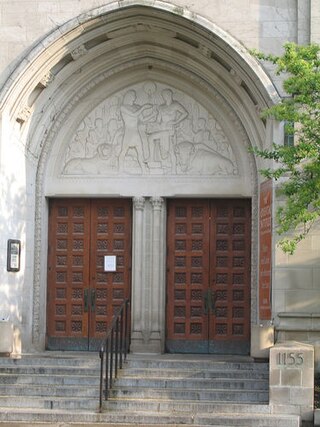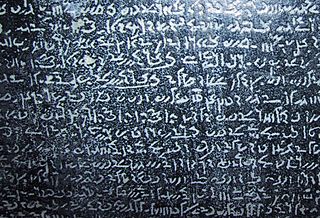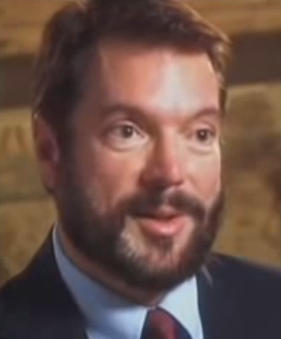Related Research Articles

The Egyptian language or Ancient Egyptian is an extinct Afro-Asiatic language that was spoken in ancient Egypt. It is known today from a large corpus of surviving texts which were made accessible to the modern world following the decipherment of the ancient Egyptian scripts in the early 19th century. Egyptian is one of the earliest written languages, first being recorded in the hieroglyphic script in the late 4th millennium BC. It is also the longest-attested human language, with a written record spanning over 4,000 years. Its classical form is known as Middle Egyptian, the vernacular of the Middle Kingdom of Egypt which remained the literary language of Egypt until the Roman period. By the time of classical antiquity the spoken language had evolved into Demotic, and by the Roman era it had diversified into the Coptic dialects. These were eventually supplanted by Arabic after the Muslim conquest of Egypt, although Bohairic Coptic remains in use as the liturgical language of the Coptic Church.

The Book of Mormon, a work of scripture of the Latter Day Saint movement, describes itself as having a portion originally written in reformed Egyptian characters on plates of metal or "ore" by prophets living in the Western Hemisphere from perhaps as early as the 6th century BC until as late as the 5th century AD. Joseph Smith, the movement's founder, published the Book of Mormon in 1830 as a translation of these golden plates. Smith said that after he finished the translation, he returned the golden plates to the angel Moroni.

Hieratic is the name given to a cursive writing system used for Ancient Egyptian and the principal script used to write that language from its development in the third millennium BC until the rise of Demotic in the mid-first millennium BC. It was primarily written in ink with a reed pen on papyrus.

Mnevis is the Hellenized name of an ancient Egyptian bull god which had its centre of worship at Heliopolis, and was known to the ancient Egyptians as Mer-wer or Nem-wer.

The Institute for the Study of Ancient Cultures, West Asia & North Africa, established in 1919, is the University of Chicago's interdisciplinary research center for ancient Near Eastern studies and archaeology museum. It was founded for the university by professor James Henry Breasted with funds donated by John D. Rockefeller Jr. It conducts research on ancient civilizations throughout the Near East, including at its facility, Chicago House, in Luxor, Egypt. The institute also publicly exhibits an extensive collection of artifacts related to ancient civilizations and archaeological discoveries at its on-campus building in Hyde Park, Chicago. According to anthropologist William Parkinson of the Field Museum, the ISAC's highly focused "near Eastern, or southwest Asian and Egyptian" collection is one of the finest in the world.
James Henry Breasted was an American archaeologist, Egyptologist, and historian. After completing his PhD at the University of Berlin in 1894, he joined the faculty of the University of Chicago. In 1901 he became director of the Haskell Oriental Museum at the university, where he continued to concentrate on Egypt. In 1905 Breasted was promoted to full professor, and held the first chair in Egyptology and Oriental History in the United States.
As used for Egyptology, transliteration of Ancient Egyptian is the process of converting texts written as Egyptian language symbols to alphabetic symbols representing uniliteral hieroglyphs or their hieratic and demotic counterparts. This process facilitates the publication of texts where the inclusion of photographs or drawings of an actual Egyptian document is impractical.

Demotic is the ancient Egyptian script derived from northern forms of hieratic used in the Nile Delta. The term was first used by the Greek historian Herodotus to distinguish it from hieratic and hieroglyphic scripts. By convention, the word "Demotic" is capitalized in order to distinguish it from demotic Greek.
Richard Anthony Parker was a prominent Egyptologist and professor of Egyptology. Originally from Chicago, he attended Mt. Carmel High School with acclaimed author James T. Farrell. He received an A.B. from Dartmouth College in 1930, and a Ph.D. in Egyptology from the University of Chicago in 1938. He then went to Luxor, Egypt to work as an epigrapher with the University of Chicago's Epigraphic and Architectural Survey, studying the mortuary temple of Ramses III. When World War II necessitated a temporary halt to the project, Parker came back to Chicago to teach Egyptology at the university. In 1946, he returned to Egypt to continue his work on the epigraphic survey, and soon rose to the position of field director.
Leonard H. Lesko was Chairman of the Department of Egyptology at Brown University and held the Charles Edwin Wilbour Professorship. In 1961, he received a B.A. in Classics from Loyola University Chicago, and his masters in 1964. In 1969, he received a Ph.D. in "Near Eastern Languages and Civilizations-Egyptology" at the University of Chicago. Prior to joining the Brown faculty in 1982, he held various teaching positions at University of California-Berkeley.
Miriam Lichtheim was a Turkish-born American-Israeli egyptologist, known for her translations of ancient Egyptian texts.

Vasily Vasilievich Struve was a Soviet orientalist from the Struve family, the founder of the Soviet scientific school of researchers on Ancient Near East history.
Hurbayt is a town in Sharqia Governorate of Egypt.
The Chicago Assyrian Dictionary (CAD) or The Assyrian Dictionary of the Oriental Institute of the University of Chicago is a nine-decade project at the University of Chicago's Oriental Institute to compile a dictionary of the Akkadian language and its dialects. Modeled on the Oxford English Dictionary, work on the project was initiated in 1921 by James Henry Breasted, the founder of the Oriental Institute, who had previously worked on the Berlin dictionary of Ancient Egyptian.
Harry Angier Hoffner, Jr. was an American professor of Hittitology.
The Chicago Hittite Dictionary (CHD) is a project at the University of Chicago Oriental Institute to create a comprehensive dictionary of the Hittite language. The project was founded by Hans Gustav Güterbock and Harry Hoffner in 1975 and funded by the National Endowment for the Humanities. It is currently co-edited by Theo van den Hout and Petra Goedegebuure. Hoffner originally hoped that the project could be completed by 2000, though as of 2005 it was expected to last until 2045. It is one of several dictionary projects at the Institute, including the Chicago Assyrian Dictionary and the Chicago Demotic Dictionary.

Robert Kriech Ritner was an American Egyptologist most recently at the Oriental Institute of the University of Chicago.
Janet Helen Johnson is an American Egyptologist and academic, specializing in Egyptian language and the Late Period of ancient Egypt. Since 2003, she has been Morton D. Hull Distinguished Service Professor of Egyptology at the University of Chicago. She was Director of Chicago's Oriental Institute from 1983 to 1989.
Ipy is an ancient Egyptian goddess of fertility. She is also known as Opet. At Karnak she is called Ipet, and in the Demotic Magical Papyrus, she is called Apet, the mother of fire.
Ola El Aguizy is an Egyptian Egyptologist and Emeritus Professor at the University of Cairo. An expert in Demotic, she has published widely on the language. Since 2005 she has led excavations at Saqqara, uncovering the tombs of several notable figures connected to Ramesses II. In 2015 her colleagues presented her with a Festschrift entitled Mélanges offerts à Ola el-Aguizy.
References
- ↑ Wilford, John Noble (2012-09-17). "Dictionary Translates Ancient Egypt Life". The New York Times. ISSN 0362-4331 . Retrieved 2021-04-27.
- ↑ Harms, William (2012-09-18). "Chicago Demotic Dictionary refines knowledge of influential language". Phys.Org. Retrieved 2021-04-27.
- ↑ "The Demotic Dictionary of the Institute for the Study of Ancient Cultures of the University of Chicago" . Retrieved 2023-07-25.